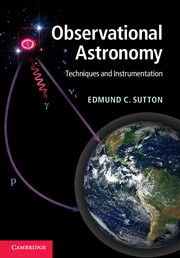Book contents
- Frontmatter
- Contents
- List of illustrations
- List of tables
- Preface
- Acknowledgements
- 1 Astrophysical information
- 2 Photometry
- 3 Positional astronomy
- 4 Fourier transforms
- 5 Detection systems
- 6 Orthodox statistics
- 7 Stochastic processes and noise
- 8 Optics
- 9 Interference
- 10 Spectroscopy
- 11 Ultraviolet, x-ray, and gamma ray astronomy
- 12 Radio receivers, spectrometers, and interferometers
- 13 Modern statistical methods
- 14 Neutrino detectors
- 15 Cosmic ray detectors
- 16 Gravitational waves
- 17 Polarimetry
- Appendix A Physical constants and units
- Appendix B Acronyms
- Appendix C Additional reading
- References
- Index
- Plates
3 - Positional astronomy
Published online by Cambridge University Press: 05 June 2012
- Frontmatter
- Contents
- List of illustrations
- List of tables
- Preface
- Acknowledgements
- 1 Astrophysical information
- 2 Photometry
- 3 Positional astronomy
- 4 Fourier transforms
- 5 Detection systems
- 6 Orthodox statistics
- 7 Stochastic processes and noise
- 8 Optics
- 9 Interference
- 10 Spectroscopy
- 11 Ultraviolet, x-ray, and gamma ray astronomy
- 12 Radio receivers, spectrometers, and interferometers
- 13 Modern statistical methods
- 14 Neutrino detectors
- 15 Cosmic ray detectors
- 16 Gravitational waves
- 17 Polarimetry
- Appendix A Physical constants and units
- Appendix B Acronyms
- Appendix C Additional reading
- References
- Index
- Plates
Summary
Fundamental reference system
The official system used for positional astronomy was introduced in 1976 by the International Astronomical Union (IAU). The changes made at that time included full consistency with the SI system of units (Le Système International d'Unités) and new experimental values for the fundamental constants (e.g. GM⊙). It became a fully relativistic system, and a new standard (reference) epoch J2000.0 was introduced. This system was first implemented in The Astronomical Almanac for 1984 (and detailed in the “Supplement” in that volume, pp. S5–S38). In 1991 the treatment of space-time coordinates was further revised. An exhaustive description of the entire system is given in the Explanatory Supplement to the Astronomical Almanac (Seidelmann, 2006). Outdated and deprecated concepts include the epoch B1950.0, Besselian day numbers, E-terms of aberration, GMT, and ephemeris time (ET).
Further refinement was required after the astrometry mission Hipparcos provided significantly improved measurements of stellar positions. In this chapter we will focus first on those aspects of positional astronomy required for general uses such as “Where do I point my telescope?” Later we will introduce some aspects of precision astrometry. The most demanding applications require a relativistic treatment which goes well beyond what we are able to cover here.
Time systems
Atomic time
The fundamental system of time is international atomic time, TAI (Temps Atomique International). It is based on a worldwide weighted average of numerous atomic clocks, most of which are cesium clocks.
- Type
- Chapter
- Information
- Observational AstronomyTechniques and Instrumentation, pp. 28 - 51Publisher: Cambridge University PressPrint publication year: 2011

